Exquisite Build
Rules:
- At the start of each round, one player will draw a card. For the first round, the first player drawing the card will be the one who has built a Lego set most recently. The card will give the object being built as well as suggestions for the topics of the multiple building stages, these topics can be changed as each judge wishes.
- The person drawing the card will act as the first judge. As the judge, they will tell the players the object being built and reveal the topic of the first building stage.
- The first collection phase will then commence, moving to the right, each player will draw a card to see the number of pieces they get for their first building phase. The collection phase will be limited to 30 seconds.
- Once each player has completed their collection phase, the first building phase will begin, each player has 30 seconds to build the given topic.
- Once the 30 seconds are up, the second collection phase will begin and will follow the same rules as the first. This will be followed by a second build phase, a third collection phase, and a third build phase. Each build phase will increase by an increment of 15 seconds.
- After the third build phase, each player will present their build of the topic to the judge, who will then select their favorite. The favorite build goes on the baseplate, and the winner gets a point. The rest of the builds are then returned to the pile
- The card is then passed to the next judge (to the left), who will determine what the next topic will be. The same process then repeats.
- A round is complete once all players have acted as the judge. Once the round is complete, everyone will take a moment to admire their finished work.
- At the start of the second round, the player sitting to the left of the first judge will pick the next card and act as the first judge for the second round.
- The game continues either until each player has acted as the starting judge, or the players don’t feel like playing anymore.
- At the end of the game, the player with the most points wins, and is crowned king of the exquisite build.
- (Optional rule): The final round is the modern art card, with which players are allowed to build whatever they want.
Artist’s Statement:
This piece was inspired heavily by the “Exquisite Corpse” piece, as well as games like Jackbox and Cards Against Humanity. During the appropriation show and tell, someone jokingly asked if Lego was a form of appropriation. Right when I heard that, I immediately latched onto the idea of using Legos as the appropriated material, but then came the question of what the game would actually be. In the past, Lego had a wave of Lego board games, and I wondered if I should do something akin to that, like a classic board game recreated in Lego, or something along those lines, however nothing really stuck for me. When I thought about my favorite games to play nowadays, I love games like Cards Against Humanity or some of the Jackbox games, where the players are all given one prompt, and each gives a unique response to be judged by the other players or another player. In particular, I really latched onto the idea of one player being a judge, and the rest building something to impress them. In addition, the Jackbox game, Civic Doodle (itself a sort of appropriation of the exquisite corpse formula) was a source of inspiration, as two players were pitted against each other to draw a subject, and then judged. The winner’s piece would then be amended by another two players, and that amendment would be judged, and so on and so on. My game sort of acts as a three dimensional version of Civic Doodle, as the players build upon the foundation set by the last round’s winner. While designing my game, I tried to draw from general concepts we’ve talked about in class, such as the transformation of an object’s purpose, collaborative creation, and creativity in the artistic method. In this game, players are forced to collaborate with each other as they build off of each other’s previous designs. In addition their piece selection and building time is limited, thus transforming the normal Lego building process, in which you are provided all the pieces you need and unlimited time to build the set you purchased into a competitive scramble to collect random pieces in order to build whatever you can in the given time. The Lego pieces act as the appropriated material despite being used as they usually are, as building blocks to make a model of something. Despite the Lego company encouraging creativity and collaboration, most Lego sets nowadays are designed to be built by one person following a given set of instructions. This game, though, uses the pieces to fulfill these values held closely by the Lego company, by encouraging the players to build more uniquely in order to win and contribute to the overall creation.
Documentation
For this shortened round, the card pulled listed:
Object: Wall
Topics: Wall
The first topic for the build was a wall with holes.

Photo 1: Here we see the two players in the midst of their first collection phase, grasping at whatever pieces they can get before the time runs out.
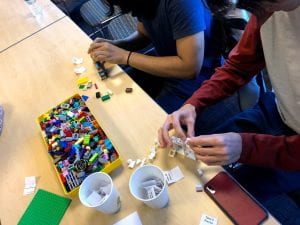
Photo 2: In the midst of the second building phase, the players designs begin to take hold as they put together what they can with the pieces they’ve acquired.
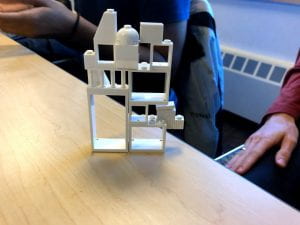
Photo 3: The first build produced, an artistic wall packed with a variety of holes of different sizes and shapes. A design completely white due to the players wishes. This wall ultimately wins the first phase.
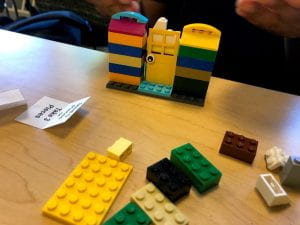
Photo 4: The other first build produced. A worth opponent, filled with a variety of colors and a non-functioning door piece. The player used the door as a barrier, without its traditional hinges, and with an eyeball as the door handle. Is this an appropriation piece in itself? Makes one wonder.
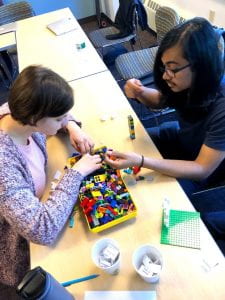
Photo 5: The second stage of the building of the wall. This time, the topic was to continue the trend of the winning wall, and to build a white wall. Here we see the two players in this second stage in the midst of their collection phase, searching for pieces.
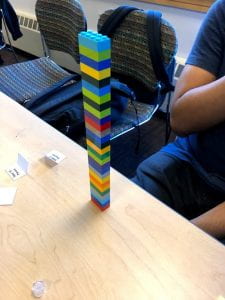
Photo 6: The winning build produced in this second stage. The player decided to stack bricks of varying color but same size and shape upon each other. He argued that since all colors of light together make white, that’s what is happening here. Truly a compelling argument.
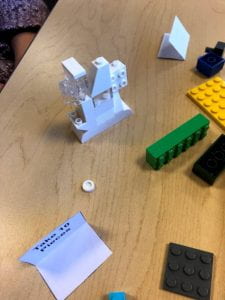
Photo 7: The other wall built in the second stage. Despite its small size, the wall consists entirely of white or clear pieces, to uphold the white aesthetic established by the first build.
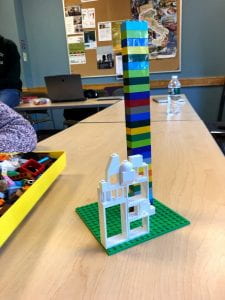
Photo 8: The two walls, placed together on the baseplate to create the final product. An artistic wall with an interesting juxtaposition between their colors.
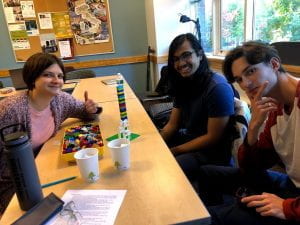
Photo 9: Fun for friends and family!
